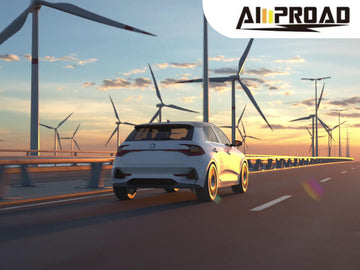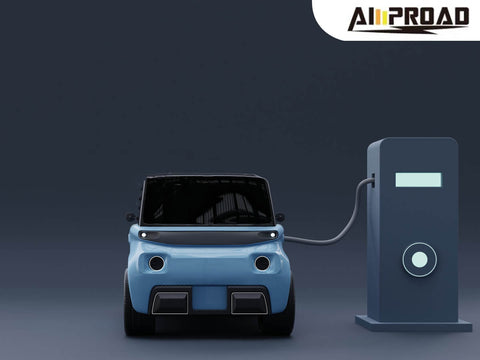
Hitting the road in your electric car but low on battery? You pull into a charging station hoping for a quick top-up, but a nagging question pops into your head: will your charging cable handle the fast charging option? Most electric vehicles (EVs) can be charged in two main ways: Level 1/2 AC charging, the slower option you might use at home or many public stations, and DC Fast Charging, a much faster method for longer trips. But here's the catch - not all EV charging cables are built the same. Some are designed for the speed and power of DC Fast Charging, while others are better suited for the slower AC options. In this article, we'll break down the difference between these cables and help you choose the right one to keep your EV running smoothly.
EVSE Cable Types
It's time to debunk the misconception that all Electric Vehicle Supply Equipment (EVSE) cables are interchangeable. The truth is, the design of EVSE cables significantly impacts charging efficiency and safety for electric vehicles (EVs). Here's why understanding cable diversity is crucial:
Supporting Different Charging Speeds and Power Outputs
Not all EVs charge at the same rate, and that's where cable design plays a crucial role. A Level 1 EV charger, often utilizing standard household outlets, delivers a slower charge suitable for overnight charging. In contrast, a Level 2 charger offers faster charging speeds by utilizing higher voltage and amperage levels. This necessitates a robust cable design capable of handling increased power flow to charge the vehicle more quickly and efficiently.
Introduction to Common Cable Connector Standards
Familiarizing yourself with common cable connector standards is vital for seamless charging experiences. The J1772 connector is ubiquitous in Level 1 and Level 2 EV chargers, providing standardized compatibility across various EV models. For even faster charging, the CCS (Combined Charging System) or SAE Combo connector integrates both AC and DC charging capabilities. Additionally, Tesla owners frequently utilize the proprietary Tesla Destination Charger connector, tailored specifically for Tesla vehicles and commonly found at Tesla charging stations.
Tailoring Cable Design to Charging Needs
Selecting the appropriate EVSE cable type aligns with your specific charging requirements. For routine charging at home or work, a Level 2 EV charger equipped with a suitable cable design offers the convenience of faster charging without frequent visits to public charging stations. However, during long-distance travel, access to fast-charging networks utilizing CCS or Tesla Destination Charger connectors becomes essential for minimizing charging durations and optimizing the EV driving experience. The NACS (North American Charging Standard) is another common cable connector standard used in electric vehicle charging. A significant shift in the electric vehicle market occurred between May 2023 and February 2024. During this period, the majority of other vehicle manufacturers announced their intentions to adopt the NACS charger port for their electric vehicles in North America, starting from the year 2025. Additionally, numerous electric vehicle charging network operators and equipment manufacturers have revealed plans to incorporate NACS connectors into their infrastructure. This widespread adoption signals a move towards standardization and interoperability within the EV charging ecosystem, promoting greater convenience and accessibility for EV owners across the region.
So, recognizing that not all EVSE cables are created equal is paramount. Cable design is pivotal in accommodating different charging speeds and power outputs, ensuring efficient and safe charging for EVs. By familiarizing yourself with common cable connector standards like J1772, CCS, and Tesla Destination Charger, you can make informed decisions when selecting charging equipment tailored to your specific needs. Whether at home, public stations, or on the road, choosing the right EVSE cable type enhances the convenience and effectiveness of your EV charging journey.
Can Your Cable Handle the Speed?
The burning question for many electric vehicle (EV) owners is whether their Level 1 or Level 2 EVSE cables can handle the rapid charging speeds of DC Fast Charging. The short answer? Unfortunately, they can't. Here's why:
Compatibility Issues
Standard Level 1 and Level 2 EVSE cables are simply not designed to handle the higher voltage and amperage associated with DC Fast Charging. While Level 1 and Level 2 chargers utilize alternating current (AC) for charging, DC Fast Chargers require direct current (DC) to deliver a rapid charge. Attempting to use a Level 1 or Level 2 cable with a DC Fast Charger can lead to compatibility issues and may even damage the vehicle's charging port or the charging infrastructure.
Design Limitations
The design of Level 1 and Level 2 EVSE cables is optimized for the lower power delivery typical of residential and slow-charging scenarios. These cables are not equipped to manage the significantly higher power output of DC Fast Chargers, which can deliver charging rates of up to 350 kW or more. Attempting to draw such high power through an incompatible cable could result in overheating, melting, or other serious safety hazards. And However, there are innovative solutions emerging to address this compatibility issue. One such solution is the AMPROAD Level 1 & Level 2 dual-use EV charger. This versatile charging solution is designed to provide both Level 1 and Level 2 charging capabilities in a single unit. While Level 1 charging is suitable for standard residential charging needs, Level 2 charging offers faster charging speeds for more convenience.
Despite its dual-use functionality, it's important to note that the AMPROAD charger is still not designed for DC Fast Charging. The cable and components are optimized for the lower power delivery of Level 1 and Level 2 charging, ensuring safe and efficient charging experiences for EV owners. As technology continues to evolve, solutions like the AMPROAD charger demonstrate the industry's commitment to providing flexible and user-friendly charging options while prioritizing safety and performance.
Potential Safety Risks
Using an incompatible cable for DC Fast Charging poses inherent safety risks. The mismatch between the cable's design and the charging requirements of a DC Fast Charger can lead to electrical faults, overheating, or even electrical fires. Moreover, attempting to force a connection with an incompatible cable may cause damage to the vehicle's charging system, resulting in costly repairs and potential safety concerns for both the vehicle and the charging infrastructure.
While Level 1 and EVSE Level 2 cables are suitable for standard residential charging needs, they are not compatible with the high-speed charging demands of DC Fast Charging. Attempting to use an incompatible cable with a DC Fast Charger can lead to safety hazards and potential damage to both the vehicle and the charging infrastructure. To ensure safe and efficient charging, it's essential to use the appropriate cable and equipment for each charging scenario, adhering to manufacturer recommendations and industry standards.
Finding the Right Cable for Your Needs
Selecting the right Electric Vehicle Supply Equipment (EVSE) cable is essential for ensuring efficient and safe charging for your electric vehicle (EV). Here's a guide to help you choose the appropriate cable based on your charging needs:
Standard Level 1/2 Charging
For most home and public AC chargers, standard Level 1 and Level 2 EVSE cables are suitable. These cables are designed to handle the lower power delivery typical of residential and slow-charging scenarios. Level 1 chargers typically utilize standard household outlets, providing a slower charge suitable for overnight charging. Level 2 chargers, on the other hand, offer faster charging speeds by utilizing higher voltage and amperage levels. When selecting an EVSE cable for standard Level 1/2 charging, ensure compatibility with your vehicle's charging port and the charging infrastructure available in your area.
DC Fast Charging
For DC Fast Charging, a specific cable with a CCS (Combined Charging System) or SAE Combo connector is required. These connectors integrate both AC and DC charging capabilities, allowing for rapid charging speeds. DC Fast Chargers are commonly found at fast charging stations along highways and major routes, offering quick refueling for long-distance travel. When using DC Fastest Charging, it's essential to use the correct cable with the appropriate connector to ensure compatibility and safety.
Why Power Delivery and Length Is So Important?
When selecting an Electric Vehicle Supply Equipment (EVSE) cable, it's crucial to consider factors beyond just the type of charging. Here's why power delivery and cable length are essential considerations:
Cable Amperage Rating for Level 2 Charging Speed
The amperage rating of the EVSE cable determines the charging speed, particularly for Level 2 charging. Cables with higher amperage ratings, such as 32 amps, can deliver faster charging speeds compared to those with lower ratings, typically 16 amps. If your electric vehicle and charging infrastructure support higher amperage levels, opting for a cable with a higher amperage rating can significantly reduce charging times, providing more convenience and flexibility.
Cable Length for Convenient Charging
The length of the EVSE cable is another critical factor to consider, as it determines the flexibility and convenience of charging in various situations. A longer cable allows for greater reach, enabling you to comfortably connect your vehicle to the charging station without the need for awkward positioning or parking adjustments. This is particularly beneficial when charging at public charging stations or in situations where the charging infrastructure is not conveniently located near your parking spot.
Moreover, the cable length also affects charging accessibility in different environments. For instance, if you frequently charge your electric vehicle at home, a longer cable may be necessary to reach the charging outlet from your parking space. Similarly, when using public charging stations, a longer cable ensures that you can easily access the charging infrastructure regardless of parking space availability or station layout.
So, when choosing an EVSE cable, it's essential to consider both power delivery and cable length to ensure efficient and convenient charging experiences. Selecting a cable with the appropriate amperage rating for your charging needs maximizes charging speed and flexibility, while opting for a suitable cable length enhances accessibility and convenience in various charging environments. By carefully evaluating these factors, you can make an informed decision and enjoy seamless electric vehicle charging wherever you go.
FAQs / People Also Ask
How do I know which amperage rating is suitable for my Level 2 charging needs?
The appropriate amperage rating for Level 2 charging depends on your electric vehicle's charging capabilities and the charging infrastructure available. Vehicles with higher charging capacities can benefit from cables with higher amperage ratings, such as 32 amps, for faster charging speeds. However, it's essential to ensure compatibility with both your vehicle and the charging station before selecting an EVSE cable with a specific amperage rating.
What factors should I consider when choosing the length of an EVSE cable?
When selecting the length of an EVSE cable, consider the distance between your vehicle's charging port and the charging outlet. Opt for a cable length that provides sufficient reach to comfortably connect your vehicle to the charging station without the need for parking adjustments or awkward positioning. Additionally, consider your charging habits and the environments where you'll be charging most frequently, such as at home or public charging stations, to determine the optimal cable length for your needs.
Can I use an EVSE cable with different connector standards interchangeably?
In most cases, EVSE cables with different connector standards are not interchangeable. Each connector standard, such as J1772, CCS, SAE Combo, and Tesla Destination Charger, is designed for specific charging systems and vehicle compatibility. Attempting to use an EVSE cable with an incompatible connector standard can result in compatibility issues and may damage the vehicle's charging system. It's essential to use the appropriate EVSE cable with the correct connector standard for safe and efficient charging.




